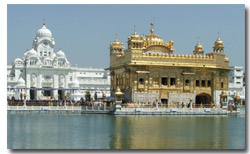| Punjab is said to have derived
its name from the five rivers that flow through this region. The Indus,
t he
Sutlej, the Beas, the Ravi and the Ghaggar which water this state make
it a part of the northern fertile plain. he
Sutlej, the Beas, the Ravi and the Ghaggar which water this state make
it a part of the northern fertile plain.
Prior to Persian period this
region was known by different names at different times. Probably, at the
height of its glory it was known as Sapta Sindhu, land of the seven rivers,
namely Sindhu (Indus), Vitasta (Jehlum), Asuhi (chenab), Purshin (Ravi),
Vipasa (Beas), Satadru (Sutleg) and Saruri (Saraswati). The last one is
a dried up stream now and its traces are found in the present seasonal
streams that flow near Pehowa in Haryana. During Greek occupation, the
territory had shrunk into the area covering the five rivers.
It was a region that formed parts of the Indus Valley civilization. The
Aryans settled in this region in about 1500B.C. It was in about 900B.C
that the battle of Kurukshetra mentioned in the Epic Mahabharata was believed
to have taken place in Kurukshetra. During this period the region formed
small principalities ruled by chieftains. In 326BC Alexander the Great
of Macedonia invaded Punjab. After this was the rule of Chandragupta Maurya
that lasted till about 1st century A.D. By 318A.D the Gupta dynasty exercised
their influence. They were followed by the Huns in about 500A.D.
By 1000A.D the Muslims invaded Punjab led by Mahmud of Ghazni. In 1030A.D
the Rajputs gained control of this territory. In about 1192A.D the
Ghoris defeated the Chauhans and ruled till the establishment of the Mughal
rule, a spirit of religious liberation led to the rise of the Militant
Sikh power. In the early, 19th century the British established
their influence. After independence this region witnessed mass migration
and distribution of property. In 1947 when India was partitioned, the
larger half of Punjab went to Pakistan. In 1966 the Indian smaller half
was further divided into three: Punjab, Haryana and Himachal Pradesh.
|

